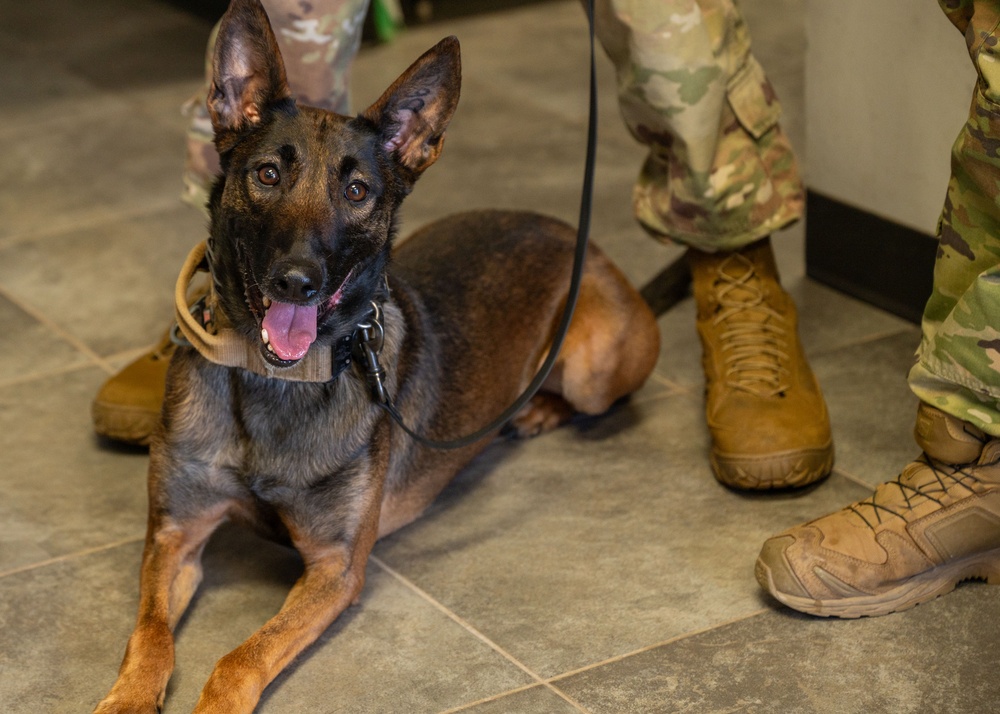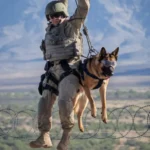Military Working Dog (MWD) handlers from Davis-Monthan Air Force Base recently collaborated with the Canine Cognition Center, a veterinarian research group from the University of Arizona, to showcase the incredible skills of their MWDs.

On February 7, 2024, three highly trained dogs demonstrated their capabilities in specialized exercises, shedding light on the effectiveness of their training.
These MWD exercises were designed to replicate real-life scenarios, especially missions outside the wire, where MWDs play a crucial role in ensuring the safety of soldiers.
U.S. Air Force Staff Sgt. Ryan Duggan of the 355th Security Forces Squadron explained that during these missions, dogs lead their handlers through dangerous terrain, sniffing for potential threats like explosives.
The handlers are trained to detect behavioral changes in their dogs, signaling when something is amiss.
“We use their behavioral shifts to locate vulnerabilities in the area,” said Duggan. These specialized dogs are trained from a young age to recognize specific odors and respond accordingly, showcasing their keen sense of smell and problem-solving abilities.
One of the highlighted techniques includes sorting odors into boxes, allowing young dogs to familiarize themselves with scents they will later need to detect.
Once a dog reacts to a familiar odor, they move into a final response, signaling a threat to the handler.
Handlers like Senior Airman Dillon Johnson shared their personal deployment experiences, recounting how they rely on their MWDs to clear routes and keep their units safe.
Johnson’s mission in Africa involved sweep exercises, route clearances, and patrols where his MWD excelled in sniffing out dangers. “Watching my dog work, picking up all the scents, and keeping us safe was incredible,” said Johnson.
The demonstration also included open-area searches where handlers act as decoys for the dogs to pursue, simulating real-life scenarios.
These MWDs showed their ability to swiftly respond to commands and engage with aggressors under their handler’s orders, further proving their invaluable role in military operations.
The event concluded with a question and answer session between the MWD handlers and representatives from the Canine Cognition Center.
This interaction fostered a deeper understanding of dog training, behavior analysis, and the mutual benefits of collaboration between military experts and academic researchers.
Contents
Conclusion
The collaboration between Military Working Dog handlers and the Canine Cognition Center at the University of Arizona emphasizes the importance of blending field expertise with academic research.
Through hands-on demonstrations, both groups gained invaluable insights into the training, handling, and behavioral science of MWDs, which will help enhance future operations and research in the field of canine cognition.
FAQ’s
What is the purpose of Military Working Dog (MWD) training?
MWD training is designed to prepare dogs for specialized tasks such as drug and bomb detection, patrol, and aggressor pursuit, helping ensure the safety of military personnel.
How do handlers identify potential threats during a mission?
Handlers watch for behavioral changes in their dogs, which indicate that the dog has detected something unusual, such as a dangerous object or substance.
What role did the Canine Cognition Center play in the collaboration?
The Canine Cognition Center observed the MWD demonstrations to learn about their handling techniques and training methodologies, enhancing their research on dog cognition.
How are young MWDs trained to detect specific smells?
Young MWDs are trained using techniques like sorting odors into boxes, allowing them to become familiar with specific smells and develop their detection skills.
What are some of the exercises demonstrated during the event?
The demonstrations included route clearance, patrol work, and open-area searches, where the dogs pursued aggressors and responded to handler commands.
What benefits resulted from the collaboration between the MWD handlers and the University of Arizona?
The collaboration fostered knowledge exchange, allowing both the military and researchers to gain a better understanding of MWD behavior and training, which can improve future training and research efforts.







